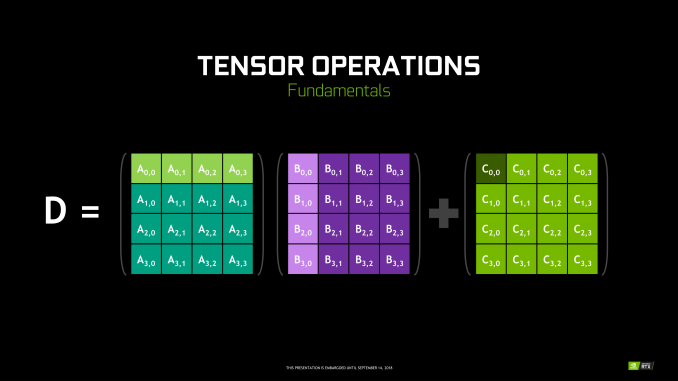The NVIDIA Turing GPU Architecture Deep Dive: Prelude to GeForce RTX
by Nate Oh on September 14, 2018 12:30 PM ESTTuring Tensor Cores: Leveraging Deep Learning Inference for Gaming
Though RT Cores are Turing’s poster child feature, the tensor cores were very much Volta’s. In Turing, they’ve been updated, reflecting its positioning as a gaming/consumer feature via inferencing. The main changes for the 2nd generation tensor cores are INT8 and INT4 precision modes for inferencing, enabled by new hardware data paths, and perform dot products to accumulate into an INT32 product. INT8 mode operates at double the FP16 rate, or 2048 integer operations per clock. INT4 mode operates at quadruple the FP16 rate, or 4096 integer ops per clock.
Naturally, only some networks tolerate these lower precisions and any necessary quantization, meaning the storage and calculation of compacted format data. INT4 is firmly in the research area, whereas INT8’s practical applicability is much more developed. Regardless, the 2nd generation tensor cores still have FP16 mode, which they now support in a pure FP16 mode without FP32 accumulator. While CUDA 10 is not yet out, the enhanced WMMA operations should shed light on any other differences, such as additional accepted matrix sizes for operands.
Inasmuch as deep learning is involved, NVIDIA is pushing what was a purely compute/professional feature into consumer territory, and we will go over the full picture in a later section. For Turing, the tensor cores can accelerate the features under the NGX umbrella, which includes DLSS. They can also accelerate certain AI-based denoisers that cleanup and correct real time raytraced rendering, though most developers seem to be opting for non-tensor core accelerated denoisers at the moment.












111 Comments
View All Comments
Yojimbo - Saturday, September 15, 2018 - link
The sites I look at put $649 2013 dollars at about $700 today. They use the CPI, the Consumer Price Index. That is the standard way to compare values over consumer goods and cost of living in general between different years where the CPI has been recorded. I have no idea where the numbers in your chart have come from. For instance, by the CPI, the 7800 GTX 512, which was released in 2005, is about $840 in 2018 dollars, and $825 in 2017 dollars, far more than the $783 listed in your chart.Note that if you have a steady 2% inflation per year over 13 years you get a 29% increase in prices.
Yojimbo - Saturday, September 15, 2018 - link
And besides, your chart, even with the wrong numbers, doesn't show what you claim to show. The 780, the 280, the 8800 GTX, and the 7800 GTX all have launch prices around the RTX 2080, even though the RTX 2080 has a bigger die than any of them.eddman - Saturday, September 15, 2018 - link
Yes it does. 2080 Ti is the most expensive geforce launch card. It's not my job, as a buyer, to dig up die sizes or even care about them. I only care about performance/price ratios which these cards are terrible at.eddman - Saturday, September 15, 2018 - link
... they are terrible because the price/performance ratio hasn't improved in any substantial way. 1080 Ti offered ~70% performance increase over 980 Ti for just ~8% higher launch MSRP.Yojimbo - Saturday, September 15, 2018 - link
OK, so when GM produced the Hummer that's directly comparable to their Suburban because they were both SUVs. It's not your job to be an intelligent creature and realize that the Hummer opened up a new market segment. Instead, spend your energy resenting GM. You can do what you want but that doesn't make it rational.eddman - Sunday, September 16, 2018 - link
... except a Hummer is a Hummer and a Suburban is a Suburban. They are not part of the same lineup. Also, a car is not a video card.2080 Ti directly follows 1080 Ti based on the naming. It's not my fault they did it. They could've named it 2090 Ti if they really meant it to be a different product category, but they didn't so based on common branding logic 2080 Ti is the successor to 1080 Ti and therefore it is not out-of-the-ordinary to expect close pricing.
Rational? What I wrote is completely rational. It is you who is trying to somehow make it look that a ~42% price jump for a 40%-45% performance increase in regular rasterized games is ok. It is not. This is probably the worst generational price/performance ratio vs. the old gen I've seen.
eddman - Sunday, September 16, 2018 - link
... unless they plan on releasing GTX 2080 Ti/2080 at lower prices, but given the potential confusion that it might cause, probably not.0ldman79 - Sunday, September 16, 2018 - link
Oddly enough, going by that comparison the H2 is built on the same platform as the Suburban.Killmorefor - Sunday, September 16, 2018 - link
That chart is pretty accurate, but would benefit from a 3D showing price drops after the next gen introduction. The chart apples, and but does not show the price jump before the chart started, nor the current jump for the next gen the OP has very good point.markiz - Monday, September 17, 2018 - link
Yeah, so what?I don't understand.. If the price is too high, they will not sell much.